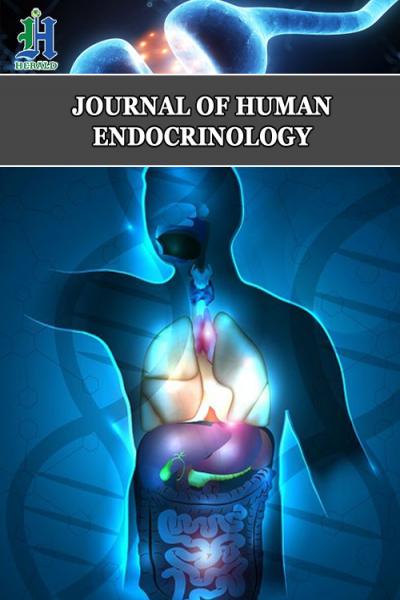
Pituitary Stalk Interruption with Varied Presentation A Case Duplet
*Corresponding Author(s):
Diksha ShirodkarDepartment Of Paediatric Endocrinology, Manipal Hospitals, Bangalore, Karnataka, India
Tel:+91 8550932269,
Email:diksha_shirodkar@yahoo.co.in
CASE REPORT
CASE 1
 Figure 1: Growth chart of case 1.
Figure 1: Growth chart of case 1. Figure 2: Left hand and wrist X-ray of case 1 showing a delayed bone age. CA=5 years 3 months. BA=2 years 2 months.
Figure 2: Left hand and wrist X-ray of case 1 showing a delayed bone age. CA=5 years 3 months. BA=2 years 2 months. Figure 3a: T1 weighted MRI brain plain (Coronal section) of case 1 showing hypoplastic anterior pituitary, absent septum pellucidum and stalk and ectopic posterior pituitary (arrow head).
Figure 3a: T1 weighted MRI brain plain (Coronal section) of case 1 showing hypoplastic anterior pituitary, absent septum pellucidum and stalk and ectopic posterior pituitary (arrow head). Figure 3b: T1 weighted MRI brain plain (Sagittal section) of case 1 showing hypoplastic anterior pituitary with absent septum pellucidum and stalk with ectopic posterior pituitary (arrow head).
Figure 3b: T1 weighted MRI brain plain (Sagittal section) of case 1 showing hypoplastic anterior pituitary with absent septum pellucidum and stalk with ectopic posterior pituitary (arrow head).CASE 2

 Figure 5: Left hand and wrist X-ray of case 2 showing a delayed bone age. CA=9 years 10 months. BA=6 years 8 months.
Figure 5: Left hand and wrist X-ray of case 2 showing a delayed bone age. CA=9 years 10 months. BA=6 years 8 months.|
Trend of Thyroid Profile |
8 year 4 Months |
8 year 7 Months |
9 year 1 Months |
9 year 10 Months |
|
TSH (mIU/ml) |
9.68 |
0.24 |
14 |
1.33 |
|
Free T4 (ng/dl) |
Not done |
2.97 |
Not done |
1.04 |
|
Treatment (Levothyroxine in mcg/day) |
25 |
12.5 |
20 |
25 |
|
Anti-Thyroid Peroxidase |
Negative |
|||
 Figure 6: MRI brain plain (Sagittal section) of case 2 showing hypoplastic anterior pituitary (pituitary height 1.5 mm) with absent infundibulum and ectopic posterior pituitary (arrow head).
Figure 6: MRI brain plain (Sagittal section) of case 2 showing hypoplastic anterior pituitary (pituitary height 1.5 mm) with absent infundibulum and ectopic posterior pituitary (arrow head).DISCUSSION
COMPARISON BETWEEN THE TWO CASES
|
|
Case 1 |
Case 2 |
|
Presenting complaints |
Poor growth velocity |
Poor growth velocity and deranged thyroid profile. |
|
Clinical features |
Infantile facies |
Infantile facies |
|
Birth history |
No asphyxia |
No asphyxia |
|
Milestones |
Gross motor delay |
Normal |
|
Anterior pituitary hormones |
GH deficiency (after GH stimulation testing with clonidine) Other hormones normal. |
Central hypothyroidism with GH deficiency (after GH stimulation testing with clonidine). |
|
Post pituitary hormones |
Normal |
Normal |
|
Neuroimaging |
Adenohypophysis, pituitary stalk and septum pellucidum not visualised. Ectopic posterior pituitary. No evidence of optic atrophy. |
Hypoplastic adenohypophysis, absent stalk and ectopic posterior pituitary. |
CONCLUSION
COMPETITIVE AND CONFLICTING INTERESTS
None
FUNDING
None
REFERENCES
- Fujisawa I, Kikuchi K, Nishimura K, Togashi K, Itoh K, et al. (1987) Transection of the pituitary stalk: Development of an ectopic posterior lobe assessed with MR imaging. Radiology 165: 487-489.
- Chen S, Leger J, Garel C, Hassan M, Czernichow P (1999) Growth hormone deficiency with ectopic neurohypophysis: Anatomical variations and relationship between the visibility of the pituitary stalk asserted by magnetic resonance imaging and anterior pituitary function. J Clin Endocrinol Metab 84: 2408-2413.
- Arrigo T, Wasniewska M, De Luca F, Valenzise M, Lombardo F, et al. (2006) Congenital adenohypophysis aplasia: Clinical features and analysis of the transcriptional factors for embryonic pituitary development. J Endocrinol Invest 29: 208-213.
- Pinto G, Netchine I, Sobrier ML, Brunelle F, Souberbielle JC, et al. (1997) Pituitary stalk interruption syndrome: A clinical-biological-genetic assessment of its pathogenesis. J Clin Endocrinol Metab 82: 3450-3454.
- Pham LL, Lemaire P, Harroche A, Souberbielle JC, Brauner R (2013) Pituitary stalk interruption syndrome in 53 postpubertal patients: Factors influencing the heterogeneity of its presentation. PLoS ONE 8: 53189.
- Olszewska M, Kie?basa G, Wójcik M, Zygmunt-Górska A, Starzyk JB (2015) A case report of severe panhypopituitarism in a newborn delivered by a women with turner syndrome. Neuro Endocrinol Lett 36: 734-736.
- Nawaz A, Azeemuddin M, Shahid J (2018) Pituitary stalk interruption syndrome presenting in a euthyroid adult with short stature. Radiol Case Rep 13: 503-506.
- Zhang Q, Zang L, Yi-Jun Li, Bai-Yu Han, Wei-Jun Gu, et al. (2018) Thyrotrophic status in patients with pituitary stalk interruption syndrome. Medicine 97: 9084.
- Guo Q, Yang Y, Mu Y, Lu J, Pan C, et al. (2013) Pituitary stalk interruption syndrome in Chinese people: Clinical characteristic analysis of 55 cases. PloS One 8: 53579.
- Tauber M, Chevrel J, Diene G, Moulin P, Jouret B, et al. (2005) Long-term evolution of endocrine disorders and effect of GH therapy in 35 patients with pituitary stalk interruption syndrome. Horm Res 64: 266-273.
- Bar C, Zadro C, Diene G, Oliver I, Pienkowski C, et al. (2015) Pituitary stalk interruption syndrome from infancy to adulthood: Clinical, hormonal, and radiological assessment according to the initial presentation. PLoS One 10: 0142354.
- Zada G, Lopes MBS, Mukundan S, Laws E (2016) Pituitary hypoplasia and other midline developmental anomalies. Atlas of sellar and parasellar lesions. Springer, Cham, Switzerland. Pg no: 493-496.
- Yamada M, Mori M (2008) Mechanisms related to the pathophysiology and management of central hypothyroidism. Nat ClinPract EndocrinolMetab 4: 683-694.
Citation: Shirodkar D, Bhattacharyya S (2019) Pituitary Stalk Interruption with Varied Presentation: A Case Duplet. J Hum Endocrinol 4: 015.
Copyright: © 2019 Diksha Shirodkar, et al. This is an open-access article distributed under the terms of the Creative Commons Attribution License, which permits unrestricted use, distribution, and reproduction in any medium, provided the original author and source are credited.

